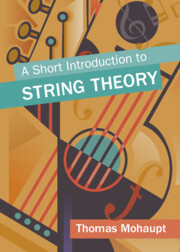‘This book provides an excellent introduction to string theory aimed at graduate students in physics and mathematics learning the subject for the first time. It gives a careful pedagogical exposition of the foundations of the subject and introduces a number of more advanced topics. It is the ideal textbook for a first graduate course on string theory.’
Chris Hull - FRS, Imperial College London
‘This book offers a gentle and lucid invitation to the vast subject of string theory, giving a systematic and self-contained exposition of the key ideas and concepts underlying its construction. It offers the reader a thorough pedagogical introduction to the interplay of the world-sheet and the space-time perspectives in string theory, supplementing the discussion with instructive homework exercises, valuable appendices as well as helpful literature references and suggestions for further reading, all of which are thoughtfully curated to provide the reader with essential background vis a vis the topics discussed in the book. As the prerequisites for the reading are kept minimal, this book is ideally suited for students with no previous exposure to the subject, but who wish to have a taste of the intellectual rewards and thrills of delving into the fascinating world of string theory.’
Gabriel Lopes Cardoso - University of Lisbon
‘With great pedagogical skill Mohaupt introduces his readers to the fascinating field of string theory. Essential concepts and many of the necessary tools are introduced, explained and applied in detail. With the careful choice of topics and the clarity of presentation, this book is ideal preparation for more advanced developments, some of which Mohaupt already whets the appetite for. I highly recommend it to ambitious undergraduate and beginning graduate students, who want to enter this area of active research.’
Stefan Theisen - Max Planck Institute for Gravitational Physics (Albert Einstein Institute)
‘Thomas Mohaupt’s book provides a clear and concise introduction into the main aspects of string theory. I can recommend the book to all physics and mathematics graduate students, who have their first encounter with the world of strings, to learn about its basics and to see its connections to particle physics, quantum field theory and quantum gravity.’
Dieter Lüst - Max Planck Institute for Physics (Werner Heisenberg Institute) and Ludwig Maximilian University of Munich
‘This book complements the existing String Theory literature providing an introduction to Strings at a level in-between that found in other text books. The book presents a self-contained, clear and pedagogical discussion of the central topics and provides insightful comments on a variety of deeper conceptual points. It provides a well-rounded introduction to the many different ingredients of String Theory and describes the bigger picture of String Theory as quantum theory of spacetime and matter. It will be particularly useful to starting to early graduate students or Physicists from other fields.’
Neil Lambert - King’s College London


